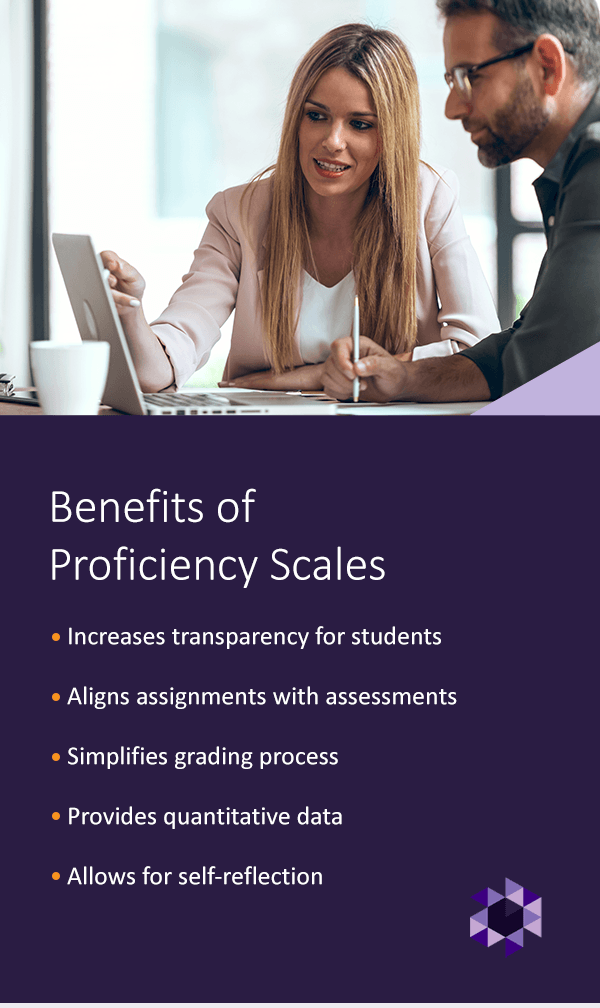
Measuring student success is essential for higher education institutions. Instructors use grading techniques to judge student progress and ensure they’re on track to receive their degrees.
Proficiency scales measure comprehension and student progression. These scales allow instructors to define proficiency, provide specific feedback, and evaluate student success. The proficiency scales at your university can reflect overall values and give students a concrete way to track their progress, making them vital tools for many educational procedures.
Academic proficiency definition
Academic proficiency is a measure of how well students understand course concepts. Higher education leaders prepare students to succeed in professional environments, making proficiency essential. The more successful students are in class, the further they can progress toward their degree.
It’s important to track how much learning has occurred while teaching a course. That way, professors can adjust teaching methods to meet student needs better. Higher education instructors and leaders have a variety of options available to measure academic proficiency. Depending on the instructor’s preferences, these strategies can vary by subject or course requirements.
For example, instructors and leaders could use direct measures like:
- Quizzes
- Exams
- Reports
- Research projects
- Oral presentations
- Or, they could use more indirect measurement methods, including:
- Course evaluations
- Student surveys
- Statistics about student retention
- Course enrollment numbers
Instructors can also use different assessment types to guide student learning throughout their course. Two major assessment approaches are:
- Summative assessments: Summative assessments include homework assignments, exams, essays, and other graded work. These assignments measure a student’s performance with percentages or letter grades. They’re usually cumulative, building off of previous concepts.
- Formative assessments: Formative assessments measure ongoing, daily learning efforts. Instructors might leave notes on essays, discuss student performance during one-on-one meetings, or provide input in other ways. Instructors could also evaluate student responses to see how well they understand the material. Formative assessments measure ongoing, daily learning efforts. For instance, instructors might ask students to write two of the most important points from the lecture at the end of class. Then, they can read the responses to gauge student understanding.
At the end of a course, instructors usually assign final grades to students. Final grades indicate a student’s level of academic proficiency and contribute to their overall grade point average (GPA).
What are proficiency scales?

Another common way to judge academic progress is with proficiency scales. These scales provide clear performance expectations for students, often in the form of rubrics. They help define students’ current level and the level they need to reach to move forward with their degree.
Proficiency scales list learning goals and different difficulty levels. Low scores usually indicate limited understanding, while high scores show mastery of a subject. Your higher education institution can use proficiency scales for the overall institution or individual courses.
While the exact proficient definition varies, proficiency scales must have three components:
- The learning goal: The scale should identify the overall learning goal of the assignment or course. For example, an oral presentation assignment could have the goal of presenting information in a clear, researched, and confident manner.
- The grading value: A proficiency scale should also explain the scoring system it uses. Many scales use the numbers one to four to indicate proficiency, with one being the lowest and four the best score. Each number should have a description explaining what the student’s score means.
- The material being evaluated: The scale should list which assignment instructors assess. For instance, the oral presentation might evaluate confidence, argument strength, supporting details, and other delivery techniques. Or an argumentative essay scale could judge organization, supporting arguments, and grammar techniques.
Instructors use proficiency scales to grade student work and performance in their classes. The scales align with course and degree objectives, making evaluating summative assessments like quizzes or essays simpler. Groups of higher education professionals can develop proficiency scales for broad use, or instructors can develop their own.
Higher education institutions also use proficiency scales for other purposes. For example, you might have a scale that tracks progress toward graduation and applies to every student. Students have to satisfy each rubric area to receive their degree. The rubric might list requirements like:
- Number of needed credit hours
- General education courses
- Minimum GPA
- Capstone or final project
Proficiency scale examples
There is a wide range of proficiency scales available. They can vary by subject type or rubric features. Consider how a scale for a mathematics course could differ from one for an English literature class — you’d need different requirements to grade fairly.
Higher education institutions use different proficiency scales for admission and grading. Here are a few examples:
Numeric proficiency scale
This common proficiency scale type uses numbers to show how well a student understands a concept. Higher education institutions often use numeric scales for grading. Lower numbers mean less understanding, while high numbers indicate proficiency in a subject. For instance, a numeric scale could include:
- Basic knowledge: Students that score a one show basic knowledge of the assignment’s material. They probably understand introductory materials and concepts, but not much else. Because it’s the lowest score option, it indicates students need more assistance. The United States’ grading system might associate this score with a “D” or “F” letter grade.
- Limited knowledge: Second-tier scores indicate more understanding than tier one, but knowledge is still limited. Tier two scores might correspond with a “C” or “D” on the U.S. grading scale.
- Proficient knowledge: The third tier signals students understand the subject enough to receive a passing grade or higher. They might earn a high “C” or “B” on the grading system.
- Exceeding knowledge: The last tier shows mastery of the topic or concepts. Students would likely receive an “A” grade for a tier-four score.
Instructors can use the numeric scale for assignments or to designate a final grade. Employers might also use this scale type to explain employees’ abilities. For instance, employees in the first tier might have just started in their position and have little experience, while tier-four employees have many years of experience.
VALUE proficiency scale
The Valid Assessment of Learning in Undergraduate Education (VALUE) is a popular proficiency scale for many higher education institutions. The American Association of Colleges and Universities (AAC&U) developed a wide range of VALUE rubrics to grade original student work in different subject areas.
For instance, instructors could choose VALUE scales for:
- Critical thinking: This rubric helps instructors evaluate assignments that test students’ ability to analyze text, data, or other issues. Critical thinking requires people to draw original conclusions, making it more complicated for instructors to give responses a direct grade. The VALUE rubric aligns the assignment with course outcomes and makes it easier to evaluate.
- Information literacy: Instructors might assess information literacy through assignments like research papers, speeches, grant proposals, marketing plans, or various other options. The VALUE rubric evaluates students’ capacity to gather and logically present information.
- Oral communication: Instructors can use the VALUE rubric for oral communication to gauge oral presentations. It measures aspects like the strength of the central message, delivery techniques, and supporting content.
- Problem-solving: Problem-solving is an essential life skill, but it can be challenging to evaluate in a classroom setting. The VALUE rubric helps evaluate these assignments based on a student’s thought processes and solutions.
- Reading: VALUE reading rubrics assess students’ reading comprehension skills.
Language proficiency scales
Higher education institutions also use proficiency scales in admissions processes. For instance, language proficiency scales measure linguistic ability in a target language. Your higher education institution might require fluency in a specific language for student admission, and their proficiency results display language ability.
These are a few popular language proficiency scales:
- American Council on Teaching Foreign Languages (ACTFL scale): The ACTFL scale divides language proficiency into four categories — novice, intermediate, advanced, and superior. It measures students’ functional abilities in a specific language.
- Inter-Agency Language Roundtable (ILR) scale: The ILR scale tests the complete range of language abilities. It divides scores into six levels from zero to five, with zero meaning little to no experience and five meaning native proficiency.
- Common European Framework Reference for Languages (CEFR) scale: This European scale measures abilities on six different levels.
Benefits of proficiency scales

Proficiency scales can bring many benefits to instructors and students. Each degree program prepares students to begin a professional career, and individual courses emphasize certain skills or concepts. Instructors can use proficiency scales to ensure students meet their degree requirements and progress satisfactorily.
Using a proficiency scale also:
- Increases transparency for students: Proficiency scales provide students with clear standards. They list the requirements for receiving the top grade and what could cause a lower score. Instructors often include the scale with their syllabus, allowing their classes to view them at any time. Students can adapt their assignments to meet these goals, making it easier to work toward higher grades. For instance, an introduction to writing class might use a proficiency rubric to score essays. Students view what’s necessary for an “A” paper and adjust their work to meet the standards.
- Aligns assignments with assessments: Proficiency scales help instructors craft assignments that align with course objectives. Keeping coursework relevant to the class goals is important — each class contributes to degree progression. Focusing on course goals ensures that every assignment is purposeful. Instructors can grade work fairly and make sure every student progresses at the right pace.
- Simplifies grading process: Your faculty and staff members have significant workloads. Professors might have to balance research and administrative responsibilities with classes, leading to tight schedules. Having a clearly defined grading scale streamlines the assessment process. Instructors can make sure students meet course objectives without spending hours finding an exact grade. Proficiency scales are especially helpful for more subjective work, such as personal essays. They can assign a grade based on the rubric instead of overthinking how to score it.
- Provides quantitative data: Quantitative data is essential for higher education institutions. Student enrollment, retention, and satisfaction data are crucial for funding. Proficiency rubrics make it easy to view student outcomes and share them with administrators. Instructors can use the data to prove their abilities, showing that a certain number of students met or exceeded expectations. Alternatively, they can use student results to adjust teaching approaches. If specific assignments or concepts had consistently lower scores, professors could try out a different method to present the information for future classes.
- Allows for self-reflection: Students can access proficiency scales anytime, making them vital tools for educational reflection. They can follow long-term scales for degree progression and monitor their strengths and areas for improvement. These tools help students become more engaged in their learning process.
How to develop a proficiency scale
From graduation requirements to grading individual course performance, your higher education institution likely uses proficiency scales in many areas. You can use established scales like the VALUE options or build individualized scales for your institution.

Developing your own scale is a rewarding process — it allows you to set clear expectations for institutional goals. These are a few tips for proficiency scale building:
- Align with institutional values: Institutional scales should correspond with the values and goals of your institution. Rubrics for individual courses might also contain connections to the overall mission of your institution. For instance, a higher education institution might emphasize the value of a well-rounded education and require students to take general foundation classes along with their major courses. Their proficiency scale for graduation might list the general foundation classes, reflecting this value.
- Remain realistic for students: It’s crucial to keep proficiency scales realistic. Requirements for top scores should be challenging but obtainable. Asking too much can overwhelm students, leading to failing grades or poor retention rates. Specific class scales can build off previous courses, making it easier for students to understand more challenging content. For instance, an introductory-level course needs less advanced understanding than a senior-level class.
- Adjust scales when needed: Remember that proficiency scales aren’t fixed, and defining academic proficiency varies by specific classes and degrees. Instructors can change them to reflect new goals or meet student needs better. If instructors notice that a particular goal is particularly difficult, they can alter it to make it more possible for students. They can also use student feedback to adjust goals and improve teaching methods.
Working with faculty and other institutional leaders is best when developing campus-wide proficiency scales. By making it a collaborative effort, you can create a comprehensive plan that reflects the goals of your institution.
Prepare a proficiency scale with Watermark
Proficiency scales give instructors meaningful insights into their students’ learning. Instructors can use student results to adapt lessons and make the classroom experience as beneficial as possible. Watermark’s Outcomes Assessment Projects can provide the tools to optimize the assessment processes.
Our solution makes it easy to use rubric-based assessments. The straightforward structure produces immediate, accessible results you can use to identify areas of improvement. Built-in filters and comparison filters let you view how scores change over time. You can scale Outcomes Assessment Projects to meet exact class needs. We develop scoring features with faculty in mind and offer robust reporting tools that include visualizations for crucial insights.
Transform your proficiency measurements with Watermark by requesting a demo today.
















































































































































































































































































































































































































